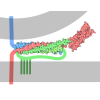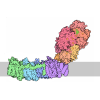+ Open data
Open data
- Basic information
Basic information
| Entry | Database: PDB / ID: 8rhn | ||||||||||||
|---|---|---|---|---|---|---|---|---|---|---|---|---|---|
| Title | Structure of the 55LCC ATPase complex | ||||||||||||
 Components Components |
| ||||||||||||
 Keywords Keywords | DNA BINDING PROTEIN / DNA replication / AAA+ ATPases / proteostasis | ||||||||||||
| Function / homology |  Function and homology information Function and homology informationpreribosome binding / mitotic spindle disassembly / VCP-NPL4-UFD1 AAA ATPase complex / retrograde protein transport, ER to cytosol / non-chaperonin molecular chaperone ATPase / polyubiquitin modification-dependent protein binding / autophagosome maturation / ribosomal large subunit biogenesis / brain development / spindle ...preribosome binding / mitotic spindle disassembly / VCP-NPL4-UFD1 AAA ATPase complex / retrograde protein transport, ER to cytosol / non-chaperonin molecular chaperone ATPase / polyubiquitin modification-dependent protein binding / autophagosome maturation / ribosomal large subunit biogenesis / brain development / spindle / spermatogenesis / proteasome-mediated ubiquitin-dependent protein catabolic process / cell differentiation / DNA replication / cell division / DNA repair / ATP hydrolysis activity / ATP binding / identical protein binding / nucleus / cytosol / cytoplasm Similarity search - Function | ||||||||||||
| Biological species |  Homo sapiens (human) Homo sapiens (human) | ||||||||||||
| Method | ELECTRON MICROSCOPY / single particle reconstruction / cryo EM / Resolution: 4.5 Å | ||||||||||||
 Authors Authors | Foglizzo, M. / Degtjarik, O. / Zeqiraj, E. | ||||||||||||
| Funding support |  United Kingdom, 3items United Kingdom, 3items
| ||||||||||||
 Citation Citation |  Journal: Cell / Year: 2024 Journal: Cell / Year: 2024Title: The SPATA5-SPATA5L1 ATPase complex directs replisome proteostasis to ensure genome integrity. Authors: Vidhya Krishnamoorthy / Martina Foglizzo / Robert L Dilley / Angela Wu / Arindam Datta / Parul Dutta / Lisa J Campbell / Oksana Degtjarik / Laura J Musgrove / Antonio N Calabrese / Elton ...Authors: Vidhya Krishnamoorthy / Martina Foglizzo / Robert L Dilley / Angela Wu / Arindam Datta / Parul Dutta / Lisa J Campbell / Oksana Degtjarik / Laura J Musgrove / Antonio N Calabrese / Elton Zeqiraj / Roger A Greenberg /   Abstract: Ubiquitin-dependent unfolding of the CMG helicase by VCP/p97 is required to terminate DNA replication. Other replisome components are not processed in the same fashion, suggesting that additional ...Ubiquitin-dependent unfolding of the CMG helicase by VCP/p97 is required to terminate DNA replication. Other replisome components are not processed in the same fashion, suggesting that additional mechanisms underlie replication protein turnover. Here, we identify replisome factor interactions with a protein complex composed of AAA+ ATPases SPATA5-SPATA5L1 together with heterodimeric partners C1orf109-CINP (55LCC). An integrative structural biology approach revealed a molecular architecture of SPATA5-SPATA5L1 N-terminal domains interacting with C1orf109-CINP to form a funnel-like structure above a cylindrically shaped ATPase motor. Deficiency in the 55LCC complex elicited ubiquitin-independent proteotoxicity, replication stress, and severe chromosome instability. 55LCC showed ATPase activity that was specifically enhanced by replication fork DNA and was coupled to cysteine protease-dependent cleavage of replisome substrates in response to replication fork damage. These findings define 55LCC-mediated proteostasis as critical for replication fork progression and genome stability and provide a rationale for pathogenic variants seen in associated human neurodevelopmental disorders. | ||||||||||||
| History |
|
- Structure visualization
Structure visualization
| Structure viewer | Molecule:  Molmil Molmil Jmol/JSmol Jmol/JSmol |
|---|
- Downloads & links
Downloads & links
- Download
Download
| PDBx/mmCIF format |  8rhn.cif.gz 8rhn.cif.gz | 950.1 KB | Display |  PDBx/mmCIF format PDBx/mmCIF format |
|---|---|---|---|---|
| PDB format |  pdb8rhn.ent.gz pdb8rhn.ent.gz | 724.8 KB | Display |  PDB format PDB format |
| PDBx/mmJSON format |  8rhn.json.gz 8rhn.json.gz | Tree view |  PDBx/mmJSON format PDBx/mmJSON format | |
| Others |  Other downloads Other downloads |
-Validation report
| Summary document |  8rhn_validation.pdf.gz 8rhn_validation.pdf.gz | 254.2 KB | Display |  wwPDB validaton report wwPDB validaton report |
|---|---|---|---|---|
| Full document |  8rhn_full_validation.pdf.gz 8rhn_full_validation.pdf.gz | 253 KB | Display | |
| Data in XML |  8rhn_validation.xml.gz 8rhn_validation.xml.gz | 649 B | Display | |
| Data in CIF |  8rhn_validation.cif.gz 8rhn_validation.cif.gz | 43.6 KB | Display | |
| Arichive directory |  https://data.pdbj.org/pub/pdb/validation_reports/rh/8rhn https://data.pdbj.org/pub/pdb/validation_reports/rh/8rhn ftp://data.pdbj.org/pub/pdb/validation_reports/rh/8rhn ftp://data.pdbj.org/pub/pdb/validation_reports/rh/8rhn | HTTPS FTP |
-Related structure data
| Related structure data |  19177MC  8cihC C: citing same article ( M: map data used to model this data |
|---|---|
| Similar structure data | Similarity search - Function & homology  F&H Search F&H Search |
- Links
Links
- Assembly
Assembly
| Deposited unit | 
|
|---|---|
| 1 |
|
- Components
Components
| #1: Protein | Mass: 101307.883 Da / Num. of mol.: 8 Source method: isolated from a genetically manipulated source Source: (gene. exp.)  Homo sapiens (human) / Gene: AFG2A, SPAF, SPATA5 / Production host: Homo sapiens (human) / Gene: AFG2A, SPAF, SPATA5 / Production host:  References: UniProt: Q8NB90, non-chaperonin molecular chaperone ATPase #2: Protein | Mass: 83362.836 Da / Num. of mol.: 4 Source method: isolated from a genetically manipulated source Source: (gene. exp.)  Homo sapiens (human) / Gene: AFG2B, SPATA5L1 / Production host: Homo sapiens (human) / Gene: AFG2B, SPATA5L1 / Production host:  References: UniProt: Q9BVQ7, non-chaperonin molecular chaperone ATPase #3: Protein | Mass: 29439.279 Da / Num. of mol.: 2 Source method: isolated from a genetically manipulated source Source: (gene. exp.)  Homo sapiens (human) / Production host: Homo sapiens (human) / Production host:  #4: Protein | Mass: 27462.139 Da / Num. of mol.: 2 Source method: isolated from a genetically manipulated source Source: (gene. exp.)  Homo sapiens (human) / Gene: CINP / Production host: Homo sapiens (human) / Gene: CINP / Production host:  |
|---|
-Experimental details
-Experiment
| Experiment | Method: ELECTRON MICROSCOPY |
|---|---|
| EM experiment | Aggregation state: PARTICLE / 3D reconstruction method: single particle reconstruction |
- Sample preparation
Sample preparation
| Component | Name: Structure of the 55LCC ATPase complex / Type: COMPLEX / Entity ID: all / Source: RECOMBINANT | |||||||||||||||||||||||||||||||||||
|---|---|---|---|---|---|---|---|---|---|---|---|---|---|---|---|---|---|---|---|---|---|---|---|---|---|---|---|---|---|---|---|---|---|---|---|---|
| Molecular weight | Value: 0.649 MDa / Experimental value: NO | |||||||||||||||||||||||||||||||||||
| Source (natural) | Organism:  Homo sapiens (human) Homo sapiens (human) | |||||||||||||||||||||||||||||||||||
| Source (recombinant) | Organism:  | |||||||||||||||||||||||||||||||||||
| Buffer solution | pH: 7.5 Details: 25 mM Tris pH 7.5, 400 mM NaCl, 5% (v/v) glycerol, 1 mM EGTA, 2 mM ADP, 2 mM MgCl2 and 1 mM TCEP | |||||||||||||||||||||||||||||||||||
| Buffer component |
| |||||||||||||||||||||||||||||||||||
| Specimen | Conc.: 3.7 mg/ml / Embedding applied: NO / Shadowing applied: NO / Staining applied: NO / Vitrification applied: YES | |||||||||||||||||||||||||||||||||||
| Specimen support | Details: Quantifoil R3.5/1 200-mesh grids (Quantifoil Micro Tools GmbH) were glow-discharged for 30 s at 12 mA and 0.38 mBar pressure using a PELCO easiGlow system (Ted Pella). Grid material: COPPER / Grid mesh size: 200 divisions/in. / Grid type: Quantifoil R3.5/1 | |||||||||||||||||||||||||||||||||||
| Vitrification | Instrument: FEI VITROBOT MARK IV / Cryogen name: ETHANE / Humidity: 100 % / Chamber temperature: 277 K / Details: blot force = 0 N blot time = 8 s |
- Electron microscopy imaging
Electron microscopy imaging
| Experimental equipment |  Model: Titan Krios / Image courtesy: FEI Company |
|---|---|
| Microscopy | Model: FEI TITAN KRIOS |
| Electron gun | Electron source:  FIELD EMISSION GUN / Accelerating voltage: 300 kV / Illumination mode: FLOOD BEAM FIELD EMISSION GUN / Accelerating voltage: 300 kV / Illumination mode: FLOOD BEAM |
| Electron lens | Mode: BRIGHT FIELD / Nominal magnification: 165000 X / Nominal defocus max: 3100 nm / Nominal defocus min: 1200 nm / Alignment procedure: COMA FREE |
| Specimen holder | Cryogen: NITROGEN / Specimen holder model: FEI TITAN KRIOS AUTOGRID HOLDER |
| Image recording | Average exposure time: 2.99 sec. / Electron dose: 37.6 e/Å2 / Film or detector model: TFS FALCON 4i (4k x 4k) / Num. of grids imaged: 1 / Num. of real images: 27595 |
| EM imaging optics | Energyfilter name: TFS Selectris / Energyfilter slit width: 10 eV / Phase plate: VOLTA PHASE PLATE |
- Processing
Processing
| EM software |
| ||||||||||||||||||||||||||||||||||||||||
|---|---|---|---|---|---|---|---|---|---|---|---|---|---|---|---|---|---|---|---|---|---|---|---|---|---|---|---|---|---|---|---|---|---|---|---|---|---|---|---|---|---|
| CTF correction | Type: PHASE FLIPPING AND AMPLITUDE CORRECTION | ||||||||||||||||||||||||||||||||||||||||
| Particle selection | Num. of particles selected: 4182380 | ||||||||||||||||||||||||||||||||||||||||
| Symmetry | Point symmetry: C2 (2 fold cyclic) | ||||||||||||||||||||||||||||||||||||||||
| 3D reconstruction | Resolution: 4.5 Å / Resolution method: FSC 0.143 CUT-OFF / Num. of particles: 165778 / Num. of class averages: 2 / Symmetry type: POINT | ||||||||||||||||||||||||||||||||||||||||
| Atomic model building | B value: 127.55 / Protocol: RIGID BODY FIT / Space: REAL | ||||||||||||||||||||||||||||||||||||||||
| Atomic model building | Source name: AlphaFold / Type: in silico model | ||||||||||||||||||||||||||||||||||||||||
| Refine LS restraints |
|
 Movie
Movie Controller
Controller



 PDBj
PDBj



